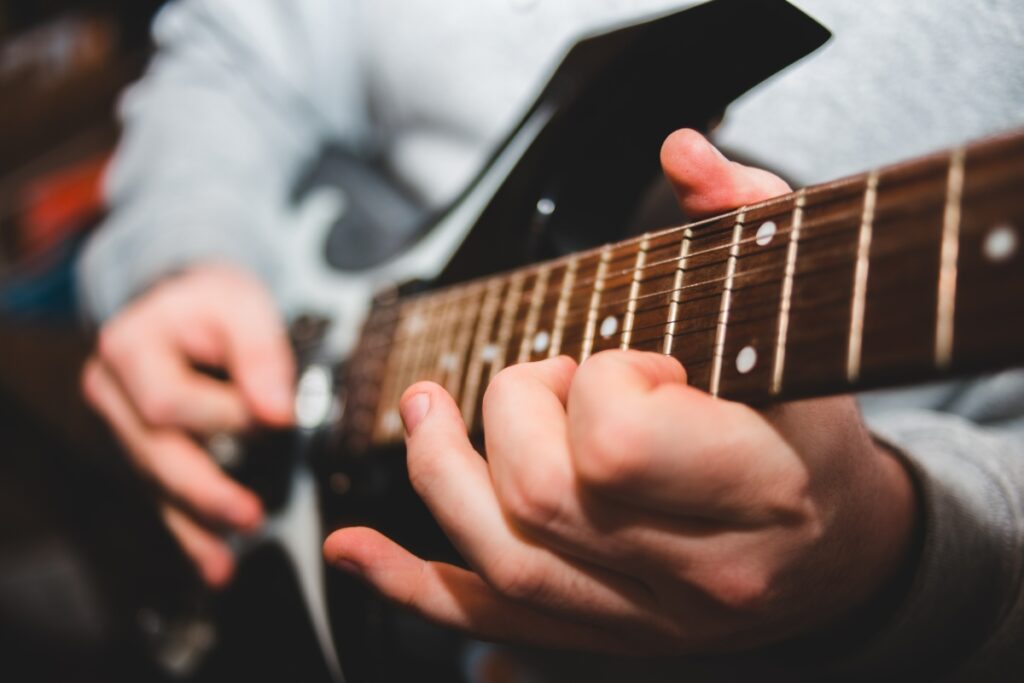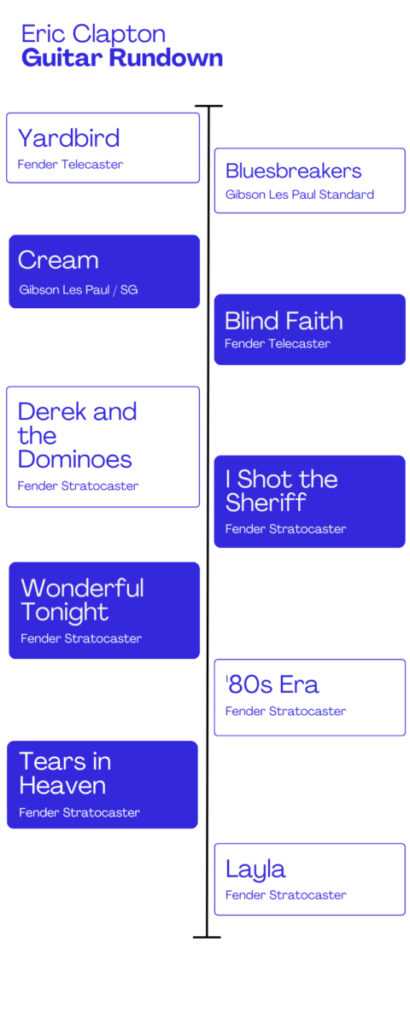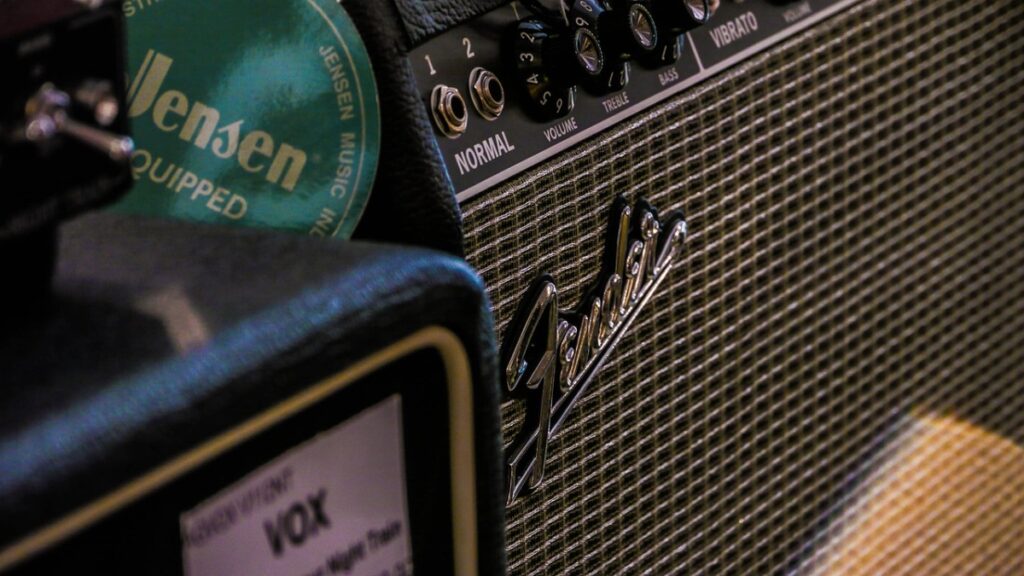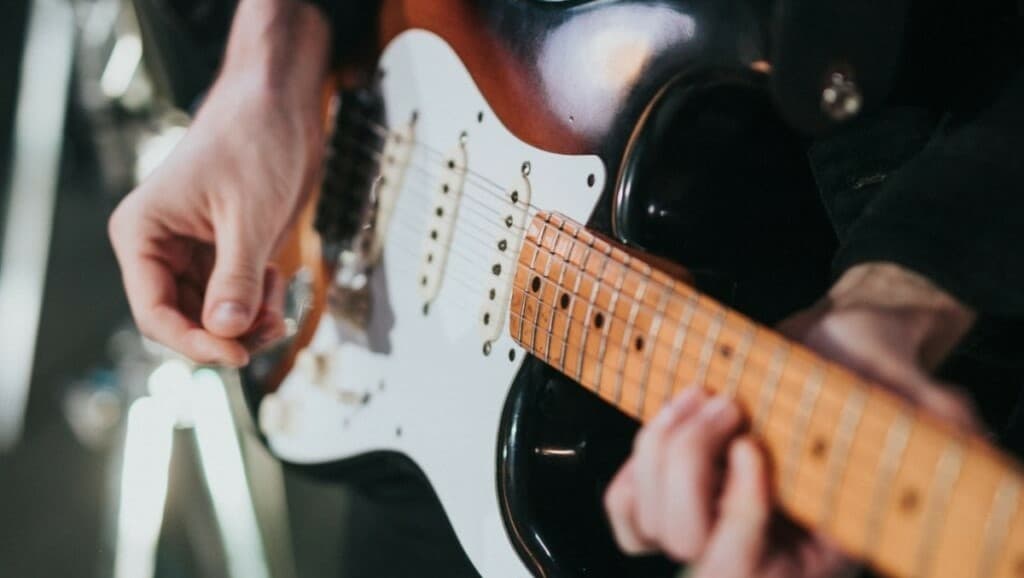Eric Clapton is one of the most well recognised guitarists of all time and many aspiring players look to emulate his iconic tone. In this article I’ll take you through the gear, amp settings and guitar settings you’ll need to get as close as possible to sounding like Clapton.
Just looking for example amp settings? Scroll down the article to get presets for some of Eric Clapton’s most popular songs.
Contents:
- Guitar, Amp and Pedals
- Guitar and Amp Settings
- Fixing Common Problems

Guitar, Amp and Pedals
In this first section I’ll run you through the equipment that Eric Clapton is most famous for using. Even if you don’t plan on buying more gear, I’d recommend reading this section through as it will help you understand where his tone comes from and how to adapt your amp and guitar settings to emulate his tone.
Guitar
Eric Clapton has used a few different electric guitars throughout his career however he is most synonymous with the Fender Stratocaster. Fender make a signature Eric Clapton Strat with the following specifications.
| Feature | Specification |
| Body Wood | Alder |
| Neck and Fretboard Wood | Maple |
| Scale | 25.5” |
| Pickups | Vintage Noiseless |
| Bridge | 6-Saddle Tremolo |
| Strings | Nickel Plated Steel 0.010-0.046” |
| Tone Control | Active |
What’s interesting about this guitar compared to a regular Strat is that it has active tone controls.
On the tone 1 control (next to the volume control) you’ll find the TBX circuit which stands for treble bass expander. It has a notch at number 5, and between 1-5 it acts as a regular tone control where you can use it to limit the treble. However, between 5-10 it is used to actively increase the treble.
This is more advanced than a regular tone control which simply restricts the treble when you roll it back and works passively.
On tone control 2, you’ll find the active mid boost. Increasing this control really beefs up the tone and makes it sound a bit more like a humbucker.
In terms of the pickups, you’ll ideally want a guitar with low-output (vintage) single coils. If you pick a guitar with high output humbuckers, then you’ll find it much more difficult to get close to Clapton’s tone on a lot of songs.
The single coils are relatively warm with a looser low-end as they use alnico II magnets. If you’re really serious about that Clapton tone, then go for alnico II magnets instead of alnico V, and certainly avoid ceramic magnets.
If you’re on a budget and the Fender Eric Clapton Stratocaster is out of reach, consider the Fender Player Plus which has noiseless single coils (although they use alnico 5 magnets), or the Fender American Performer Strat which uses a mix of alnico 2 and 4 magnets.
You can also consider the Squier Classic Vibe, however this guitar uses alnico 3 magnets.
Links to guitars:
- Fender Eric Clapton Stratocaster
- Fender American Performer Stratocaster
- Fender Player Plus
- Squier Classic Vibe Stratocaster
If you’re looking to emulate Clapton’s ’70s-’90s tone then a Strat will fit the bill for most songs, however you will probably want to go with a Gibson Les Paul if you are looking to achieve his Bluesbreakers and Cream tone.
Here is a timeline of the guitars used by Eric Clapton throughout different points in his career.

Amplifier
Eric Clapton has used Fender and Marshall amps primarily for most of his career. However, he is probably most associated with Fender, and most notably the Fender ’57 Custom Twin. This is the kind of amp to go for if your looking for his early ’80s tone in particular.
The problem with this amp though is that it is incredibly loud, and to push it to the right level of overdrive, it’s just too loud for most people, especially those who are just playing at home. Instead, you can go for something like a Fender ’57 Custom Champ which has a lower wattage so isn’t nearly as loud.
You can always use an amp attenuator as well if you need to get your amp even quieter.
In Clapton’s earlier career, for example in the Cream and Bluesbreaker era of the mid-late ’60s, he used Marshall amplifiers instead. Marshall amps typically offer more distortion and mid-range emphasis compared to Fender amps which sound brighter and cleaner.
Pedals
You don’t need a tonne of pedals to sound like Clapton, but there are some specific songs where effects pedals are pretty essential e.g.
- Wah is used in “White Room”
- Tremolo is used in “My Father’s Eyes”
- Chorus is used in a lot of songs in the ’80s in particular on a low level

Guitar and Amp Settings
In this next section I wanted to unpack the amp and guitar settings you’ll need to sound more like Clapton. It’s important to remember though that you’ll probably need to make some tweaks depending on your current rig, so I’ll address some common issues and how to fix them after the presets section.
Guitar Controls
If you’re a beginner then I’d advise having your tone and volume controls on your guitar on maximum and adjusting the sound using just your amp until you are confident using your amplifier. Then all you need to worry about is your pickup selector.
There isn’t really a one size fits all answer here as it depends on the song, and what pickups your guitar has.
For example, for “Layla” I’d go with position 1 (bridge only) on a Strat, but then if I was playing “Wonderful Tonight” I’d go with position 3 (middle pickup). This would all change if I was using a guitar with humbuckers as well.
Here are some take home messages to help you decide which settings to use:
- The bridge pickup sounds brighter and more aggressive in comparison to the neck pickup which sounds warm and mellow
- Single coil pickups sound brighter but thinner than humbucker pickups so you will need to adjust the pickup position accordingly. For example, position 3 (middle pickup) on a Strat might translate most closely to the bridge pickup on a Les Paul.
Amp Settings
Again, there’s no “one size fits all” answer here as it depends on the song and the guitar you’re using.
Let’s start by discussing the gain and amp channels.
For a lot of Clapton songs you’ll probably want to go with the overdrive/ crunch channel (as opposed to the clean channel) and start with the gain on 3-4. However, some songs such as “Wonderful Tonight” typically sound best using the clean channel.
When it comes to the EQ balance, it again is song dependent but I’d say for most songs starting with the following settings will give you a good basis to begin with:
- Bass: 4-5
- Mids: 6-7
- Treble: 6-7
If the tone sounds a bit too tight and lacks warmth, turn up the bass. If you need more depth and are struggling to cut through the mix, increase the mids. If you need more clarity and definition, increase the treble.
If you are using a guitar with humbuckers I recommend using the bridge pickup and dialling back the bass and mids on your amp and increasing the treble.
If you are using a guitar with single coil pickups then I’d advise using the middle pickup on a 3-pickup guitar or the neck and bridge in combination if you are using a 2-pickup guitar. You will also probably need to increase the mids and bass quite a bit on your amp.
Check out my complete guide to guitar amp settings to get a good understanding of the different controls and how to use them most effectively.
Presets
In this next section I’ll give you some example amp and guitar settings for some of Clapton’s most popular songs. These are not the exact settings he used but I’ve designed them to get as close as possible with a basic rig.
Keep in mind that the settings below will vary depending on which guitar you’re using. Check out the troubleshooting section after the presets for more help dialling in the right tone.
Wonderful Tonight
Settings below assume you are using a Fender Strat and Fender amplifier:
- Pickup position: 3 (middle pickup)
- Channel: clean
- Gain: 5
- Bass: 5
- Mids: 4
- Treble: 6
- Effects: reverb, delay and chorus
Crossroads
Settings below assume you are using a Gibson SG/ Les Paul and Marshall amplifier:
- Pickup position: neck and bridge in combination
- Channel: overdrive
- Gain: 4
- Bass: 4
- Mids: 8
- Treble: 7
- Effects: reverb and delay
Layla
Settings below assume you are using a Fender Strat and Fender amplifier:
- Pickup position: 1 (bridge pickup)
- Channel: overdrive
- Gain: 5
- Bass: 5
- Mids: 7
- Treble: 7
- Effects: reverb
Sunshine of Your Love
Settings below assume you are using a Gibson SG/ Les Paul and Marshall amplifier:
- Pickup position: neck pickup
- Channel: overdrive
- Gain: 4
- Bass: 5
- Mids: 8
- Treble: 5
I Shot the Sheriff
Settings below assume you are using a Fender Strat and Fender amplifier:
- Pickup position: 1 (bridge pickup)
- Channel: clean
- Gain: 4
- Bass: 4
- Mids: 7
- Treble: 7
- Effects: delay and reverb
My Father’s Eyes
Settings below assume you are using a Fender Strat and Fender amplifier:
- Pickup position: 1 (bridge pickup)
- Channel: clean
- Gain: 3
- Bass: 5
- Mids: 6
- Treble: 6
- Effects: tremolo

Fixing Common Problems
Depending on what equipment you’re using, you may need to make adjustments to your amp settings in order to dial in the best tone.
Below I’ve listed some common problems and multiple different fixes. I’d advise working your way down the list making one tweak at a time and listening for the differences. This is the most efficient way of diagnosing the issue and allows you to understand your amp more.
Tone Sounds Too Harsh and Bright
- Switch to the neck pickup if you are using the bridge or middle
- Decrease the treble
- Increase the bass
Thin Tone
- Increase the mids
- Increase the bass
- Increase the gain
Dry and Flat Tone
- Add more reverb
- Increase the mids
- Increase the bass
Muddy Tone
Check out my guide on how to fix a muddy amp for more causes and fixes.
Check out this article with amp settings for over 40 popular rock songs if you are looking for more inspiration.
